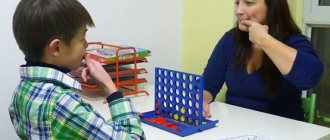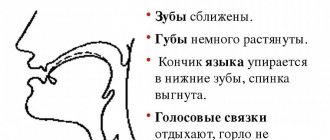www.Logopedy.ru
Gorbunova Alfiya Mullakhmatovna teacher-speech therapist Municipal budgetary preschool educational institution Kindergarten No. 13 “Ryabinka” Tchaikovsky, Perm Territory (article in MS_Word 41KB )
Often, speech therapists have to deal with persistent problems with sound pronunciation in children. General speech underdevelopment, erased dysarthria, and often even polymorphic dyslalia are combined with neurological symptoms. Children with such speech pathology, as a rule, are somatically weakened, suffer from movement disorders, have low performance, and increased fatigue. Some logopathic children are hyperactive, others, on the contrary, are asthenic. In such cases, long-term corrective influence on the child is required. At the same time, for successful speech therapy work, classes must be dynamic, emotionally pleasant, and interesting to the child. It is in such situations that a speech therapist can use unconventional methods.
Non-traditional methods of activating the organs of articulation can be used not only in working with pathology, but also as a preventive measure.
Consistent positive results are obtained from the use of non-traditional methods for the prevention of complex speech disorders in young children at risk for speech development. In most children, when using unconventional methods, the functioning of the central nervous system is normalized. Signs of this are: normalization of the tone of the articulatory and facial muscles, activation of fine differentiated and formation of arbitrarily coordinated movements of the organs of articulation, partial elimination of pathological symptoms (hypersalivation, synkinesis, deviation). As a result, the sounds of early ontogenesis actively appear, and the interdental pronunciation of whistling sounds is normalized. Most of these children subsequently do not need speech therapy work, since sounds are formed and introduced into speech spontaneously. The general somatic health of children also improves, and the adaptation period in preschool educational institutions goes more smoothly.
The non-traditional methods used in our kindergarten are easy to use, accessible, effective, do not require expensive equipment, have virtually no contraindications or age limits, and a person-centered approach to working with a child gives an excellent effect.
We can say with confidence that the complex of non-traditional methods we use refers to health-saving technologies.
Article "Bioenergoplasty - an unconventional form of articulatory gymnastics"
Bioenergoplasty is an unconventional form of articulatory gymnastics
A.G. Manushina, teacher-speech therapist, MBDOU "Kindergarten "Solnyshko", Onega
Modern socio-economic conditions place new demands on the preschool education system. At the present stage, a transition has been made to a new level of education. With the advent of the new federal state educational standard, the search for new forms and methods of teaching and raising children has become one of the pressing issues of pedagogy. Increased attention to the development of a child’s personality is associated with the possibility of updating and qualitatively improving his speech development. Therefore, along with generally accepted techniques, it is quite justified to use original, creative techniques, the effectiveness of which is obvious. And in this case, bioenergoplasty, as one of the methods of health-saving technologies, is an effective means of correcting sound pronunciation in preschool children.
Speech sounds are formed as a result of complex movements of the tongue, lips, jaws, and for each of them there is a certain articulation pattern. Even minor deviations from the norm in the location of the organs of articulation lead to defective pronunciation of speech sounds. Therefore, it is very important to form the necessary articulatory patterns and develop various muscles of the speech apparatus. For this purpose, speech therapists successfully use articulation gymnastics in their work, which includes a set of specific exercises aimed at improving the basic movements of the articulation organs. Daily gymnastics classes, unfortunately, reduce children's interest in this process, which, in turn, leads to a decrease in the effectiveness of performing articulation exercises. Therefore, we turned to an unusual and non-standard method of performing articulatory gymnastics - the use of bioenergoplasty. Such gymnastics helps to maintain the child’s interest for a long time, helps to increase the motivational readiness of children for classes, and maintains a positive emotional mood of the student and teacher.
The goal of articulatory gymnastics is to develop correct, full-fledged movements of the articulatory organs necessary for correct sound pronunciation, and to combine simple movements into complex articulatory patterns of sounds together with movements of the hands. For the correctional work of speech therapists, the most significant is the combination of bioenergoplasty (smooth movements of the hands) with movements of the organs of the articulatory apparatus. When performing an articulation exercise, the hand shows where and in what position the tongue, lower jaw or lips are located.
To achieve better results when preparing the articulatory apparatus for producing sounds, so that the process is more entertaining and captivates children, we use a method such as bioenergoplasty. To all classic articulation exercises we add the movement of the hand. To increase motivational readiness and maintain the child’s interest for a long time when performing gymnastics, we use a non-standard method of performing exercises - articulatory gymnastics with bioenergoplasty.
The term “bioenergoplastics” consists of two words: bioenergy and plastic. According to I.V. Kuris, bioenergy is the energy that is inside a person. Plasticity is smooth, liberated movements of the body and hands, which are the basis of bioenergoplasty. “Bioenergoplastics” includes three basic concepts: bio - a person as a biological object: energy - the force necessary to perform certain actions; plasticity is a movement associated with plasticity, which is characterized by continuity, energetic fullness, and emotional expressiveness.
For the correctional work of speech therapists, the most significant is the combination of bioenergoplasty (movements of the hands) with movements of the organs of the articulatory apparatus. When performing an articulation exercise, the hand shows where and in what position the tongue, lower jaw or lips are located. Such gymnastics helps to retain the child’s interest for a long time, helps to increase children’s interest in performing articulatory gymnastics, and maintains a positive emotional mood in children and the teacher throughout the entire lesson. The use of bioenergoplasty effectively speeds up the correction of defective sounds in children, since the working palm repeatedly amplifies the impulses going to the cerebral cortex from the tongue. It has a beneficial effect on enhancing the intellectual activity of children and develops fine motor coordination. The use of bioenergoplasty effectively speeds up the correction of defective sounds in children with reduced and impaired kinesthetic sensations, since the working palm greatly enhances the impulses going to the cerebral cortex from the tongue. Bioenergoplasty optimizes the psychological basis of speech, improves the child’s motor abilities in all respects, and promotes the correction of sound pronunciation and phonemic processes. Synchronizing work on speech and fine motor skills halves the time of classes, not only without reducing, but even increasing their effectiveness. It allows you to quickly remove the visual support - the mirror - and move on to performing exercises based on sensations. This is especially important since in real life children do not see their articulation.
Advantages of using a set of articulation exercises with elements of bioenergy plastic:
Optimizes the psychological basis of speech.
Improves the child's motor abilities in all respects.
Promotes correction of sound pronunciation and phonemic processes.
Synchronizing work on speech and fine motor skills reduces the time of classes and enhances their effectiveness.
Allows you to quickly remove the visual support – the mirror and move on to performing exercises based on sensations.
Thus, the use of articulatory gymnastics with bioenergoplasty helped to attract children’s interest in performing exercises, which significantly increased the effectiveness of gymnastics, contributed to the development of articulatory and finger motor skills, improved coordination of movements, and the development of memory, attention, and thinking. Performing elements of gymnastics with the hands and tongue requires the child to have maximum concentration of visual and auditory attention, developed spatial orientation, precise movements of the fingers and hands together with movements of the tongue or lips. Strong motivation and the use of the game method in classes developed and strengthened the muscles of the articulatory apparatus, which greatly facilitated the formulation and introduction of sounds into speech.
The use of bionergoplasty helps to achieve positive results in a short time. Dynamic exercises normalize muscle tone, switchability of movements, making them precise, easy, and rhythmic. The use of bioenergoplastics creates the prerequisites for the development of coordination, voluntary behavior, memory attention and other mental processes.
Literature
Zaitseva I. Yu. The influence of bioenergy plastics classes on the speech development of preschool children. — Access mode: https://festival.
Dudiev V.P. Means for the development of fine motor skills in children with speech impairment. //Defectology. 1999. N4. Krause, E. N.
Lazarenko O.I. Training the articulatory apparatus and fingers // Education and training of children with developmental disorders. M., 2006. No. 2. P. 28.









